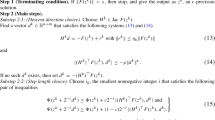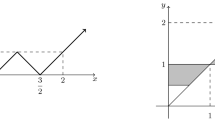Abstract
In this paper, we extend the literature by adapting the Nikaidô–Isoda function as an indicator function termed as regularized indicator Nikaidô–Isoda function, and this is demonstrated to guarantee existence of a solution. Using this function, we present two constrained optimization reformulations of the generalized Nash equilibrium problem (GNEP for short). The first reformulation characterizes all the solutions of GNEP as global minima of the optimization problem. Later this approach is modified to obtain the second optimization reformulation whose global minima characterize the normalized Nash equilibria. Some numerical results are also included to illustrate the behaviour of the optimization reformulations.
Similar content being viewed by others
References
Bensoussan A.: Points de Nash dans le cas de fontionnelles quadratiques et jeux differentiels linéaires à à N personnes. SIAM J. Control 12, 460–499 (1974)
Contreras J., Klusch M., Krawczyk J.B.: Numerical solutions to Nash–Cournot equilibria in coupled constraint electricity markets. IEEE Trans. Power Syst. 19, 195–206 (2004). doi:10.1109/TPWRS.2003.820692
Facchinei F., Kanzow C.: Generalized Nash equilibrium problems. Ann. Oper. Res. 175, 177–211 (2010). doi:10.1007/s10479-009-0653-x
Fl am, S.D., Ruszczyński, A.: Noncooperative convex games: computing equilibria by partial regularization, IIASA, Laxenburg, Working Paper 94-42 (1994)
Fukushima M.: Equivalent differentiable optimization problems and descent methods for asymmetric variational inequality problems. Math. Program. 53, 99–110 (1992). doi:10.1007/BF01585696
Gabay, D., Moulin, H.: On the uniqueness and stability of Nash-equilibria in noncooperative games, Applied stochastic control in econometrics and management science, pp. 271–293, Contrib. Econ. Anal., 130, North-Holland, Amsterdam (1980)
Gürkan G., Pang J.-S.: Approximations of Nash equilibria. Math. Program. 117, 223–253 (2007). doi:10.1007/s10107-007-0156-y
Harker P.T.: Alternative models of spatial competition. Oper. Res. 34, 410–425 (1986). doi:10.1287/opre.34.3.410
Harker P.T.: Generalized Nash games and quasi-variational inequalities. Eur. J. Oper. Res. 54, 81–94 (1991). doi:10.1016/0377-2217(91)90325-P
Huang X.X., Yang X.Q.: A unified augmented Lagrangian approach to duality and exact penalization. Math. Oper. Res. 28, 533–552 (2003). doi:10.1287/moor.28.3.533.16395
Jofré A., Wets R.J.-B.: Continuity properties of Walras equilibrium points. Stochastic equilibrium problems in economics and game theory. Ann. Oper. Res. 114, 229–243 (2002). doi:10.1023/A:1021022522035
Lalitha C.S.: A new augmented Lagrangian approach to duality and exact penalization. J. Global Optim. 46, 233–245 (2010). doi:10.1007/s10898-00909420-4
Leyffer S., Munson T.: Solving multi-leader-common-follower games. Optim. Methods Softw. 25, 601–623 (2010). doi:10.1080/10556780903448052
Lions J.-L., Stampacchia G.: Variational inequalities. Comm. Pure Appl. Math. 20, 493–519 (1967). doi:10.1002/cpa.3160200302
Mastroeni G.: Gap functions for equilibrium problems. J. Glob. Optim. 27, 411–426 (2003). doi:10.1023/A:1026050425030
Nikaidô H., Isoda K.: Note on noncooperative convex games. Pac. J. Math. 5, 807–815 (1955)
Rockafellar R.T.: Augmented Lagrangian multiplier functions and duality in nonconvex programming. SIAM J. Control Optim. 12, 268–285 (1974). doi:10.1137/0312021
Steor J., Bulirsch R.: Introduction to Numerical Analysis, Third Edition, Springer, Texts in Applied Mathematics, 12. Springer, New York (2002)
Uryasev S., Rubinstein R.Y.: On relaxation algorithms in computation of noncooperative equilibria. IEEE Trans. Automat. Control 39, 1263–1267 (1994). doi:10.1109/9.293193
von Heusinger A., Kanzow C.: Optimization reformulations of the generalized Nash equilibrium problem using Nikaidô–Isoda-type functions. Comput. Optim. Appl. 43, 353–377 (2009). doi:10.1007/s10589-007-9145-6
Author information
Authors and Affiliations
Corresponding author
Rights and permissions
About this article
Cite this article
Lalitha, C.S., Dhingra, M. Optimization reformulations of the generalized Nash equilibrium problem using regularized indicator Nikaidô–Isoda function. J Glob Optim 57, 843–861 (2013). https://doi.org/10.1007/s10898-012-9978-0
Received:
Accepted:
Published:
Issue Date:
DOI: https://doi.org/10.1007/s10898-012-9978-0
Keywords
- Generalized Nash equilibrium problem
- Regularized indicator Nikaidô–Isoda function
- Optimization reformulations
- Normalized Nash equilibria
- Quasi-variational inequality problem




